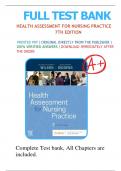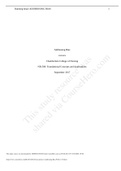Examen
Test Bank For Health Assessment for Nursing Practice, 7th Edition by Susan F Wilson, Jean Foret Giddens All Chapters 1-24
Test Bank For Health Assessment for Nursing Practice, 7th Edition by Susan F Wilson, Jean Foret Giddens All Chapters 1-24
[Montrer plus]










